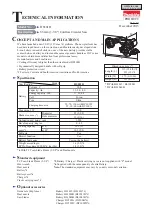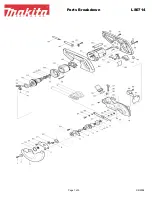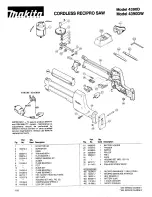
4
ENGLISH
(Original instructions)
5
ENGLISH
(Original instructions)
u
Be aware of hidden hazards, before cutting into walls,
floors or ceilings, check for the location of wiring and
pipes.
u
The blade will continue to move after releasing the
switch.
Always switch the tool off and wait for the saw
blade to come to a complete standstill before putting the
tool down.
Warning! The vibration emission value during actual use of
the power tool can differ from the declared value depending
on the ways in which the tool is used. The vibration level may
increase above the level stated.
u
The intended use is described in this instruction manual.
The use of any accessory or attachment or performance
of any operation with this tool other than those
recommended in this instruction manual may present a
risk of personal injury and/or damage to property.
Safety of others
u
This appliance is not intended for use by persons
(including children) with reduced physical, sensory or
mental capabilities, or lack of experience and knowledge,
unless they have been given supervision or instruction
concerning use of the appliance by a person responsible
for their safety.
u
Children should be supervised to ensure that they do not
play with the appliance.
Vibration
The declared vibration emission values stated in the technical
data and the declaration of conformity have been measured in
accordance with a standard test method provided by
EN 62841 and may be used for comparing one tool with
another. The declared vibration emission value may also be
used in a preliminary assessment of exposure.
Warning! The vibration emission value during actual use of
the power tool can differ from the declared value depending
on the ways in which the tool is used. The vibration level may
increase above the level stated.
When assessing vibration exposure to determine safety
measures required by 2002/44/EC to protect persons regularly
using power tools in employment, an estimation of vibration
exposure should consider, the actual conditions of use and the
way the tool is used, including taking account of all parts of
the operating cycle such as the times when the tool is
switched off and when it is running idle in addition to the
trigger time.
Residual risks.
Additional residual risks may arise when using the tool which
may not be included in the enclosed safety warnings. These
risks can arise from misuse, prolonged use etc.
Even with the application of the relevant safety regulations
and the implementation of safety devices, certain residual
risks can not be avoided. These include:
u
Injuries caused by touching any rotating/moving parts.
u
Injuries caused when changing any parts, blades or
accessories.
u
Injuries caused by prolonged use of a tool. When using
any tool for prolonged periods ensure you take regular
breaks.
u
Impairment of hearing.
u
Health hazards caused by breathing dust developed when
using your tool (example:- working with wood, especially
oak, beech and MDF.)
Labels on tool
The following pictograms are shown on the tool:
:
Warning!
To reduce the risk of injury, the user must
read the instruction manual.
Additional safety instructions for batteries and
chargers
Batteries
u
Never attempt to open for any reason.
u
Do not expose the battery to water.
u
Do not store in locations where the temperature may
exceed 40 °C.
u
Charge only at ambient temperatures between 10 °C and
40 °C.
u
Charge only using the charger provided with the tool.
u
When disposing of batteries, follow the instructions given
in the section "Protecting the environment".
p
Do not attempt to charge damaged batteries.
Chargers
u
Use your Stanley FatMax charger only to charge the






























